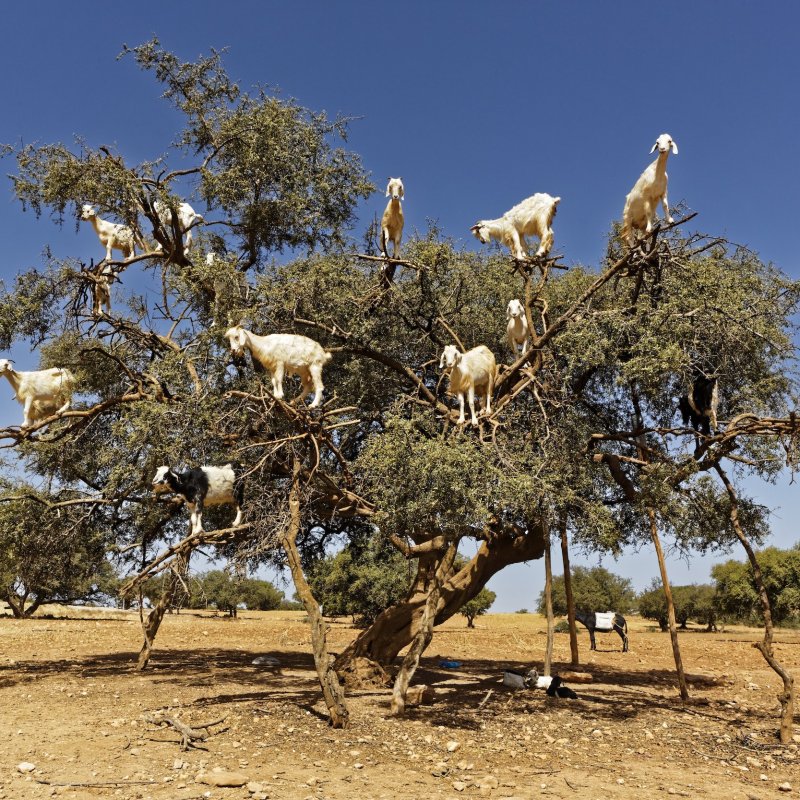
Note: The Travel Awaits team regularly updates content to provide the latest, and most accurate information to our readers. The updated content in this article may not reflect the views or opinions of the original author.
When you travel the world, you’ll find all kinds of interesting animals doing unexpected things. If you’re an animal lover, you’ll set your sights on destinations like Australia, where sugar gliders swoop through the air and quokkas snuggle up to visitors on Rottnest Island in the hopes of getting some fresh greens from the Melaleuca bush tops nearby. But the rest of the world has some pretty interesting animal situations, too, including the goats in trees in Morocco.
Why Do Moroccan Goats Climb Trees?
As you travel through Morocco, you might catch a glimpse of some goats hanging out on the branches of the Argania — or argan — trees, chowing down on some green or brown bean-like fruit. The tree is prickly and thorny, so a lot of critters wouldn’t ever risk climbing it, but these goats are in it for the tasty fruit. In fact, their love of the fruit is exactly what convinces the cloven-hooved kids to climb.
The country’s natural food sources for animals can be meager, so the goats are pretty determined to get to this tasty dinner. If they’ve eaten all the low-hanging fruit of the season, they’ll hop up into the branches and get to eat whatever’s available.
Goats can also be found climbing trees in other regions with argan trees, such as Algeria and Tunisia. These goats are attracted to the argan tree’s fruit, and their climbing behavior helps with seed dispersal, aiding in the tree’s reproduction.

The Role Of Argan Oil
The nut of the Argania tree is used to produce argan oil, which is used for cosmetic and culinary purposes. So while you might think the farmers of Argania trees would discourage this fruit consumption by these hairy creatures, many landowners actually encourage them to consume the fruit for a couple of reasons. The first is argan oil.
Goats simply can’t digest the fruit’s seed, no matter how much they enjoy eating it. Their munching on them, though, strips away the skin and fruit. They then swallow the seed or spit it out, meaning a clean, spit-out seed or one that’s passed through their digestive system and been “softened.”
This softening of the seeds, thanks to the goat’s digestive juices, makes the nuts useable for producing argan oil.
If you’ve ever heard about two of the most expensive coffees in the world — Kopi Luwak or Black Ivory — you know that argan oil isn’t the only thing consumed by humans that comes from, well, poop. But if you’re rethinking your argan cooking oil products about now, you might be comforted by the fact that the excreted seeds are typically turned into cosmetics rather than cooking oil. The rest is “filtered” via other means to avoid the “ick” factor.
The Role Of Modern Tourism
Tourism is another primary reason you’ll see goats in the trees. Farmers formerly encouraged them to jump up so they could do their part in “cleaning” the argan seeds, but now it’s more about keeping tourists coming to see the uniquely behaving quadrupeds and their happy munching. Many of the farmers charge for a variety of things, like taking photos, posing with the goats, and so on. Tour buses bring in groups to see the goats and the tour companies give a stipend or tip to farmers for allowing them to bring sightseers by for the stop on the way to other Moroccan destinations.
If you try to take a photo without paying, know that you might be asked for money.

How To See The Goats
To see these critters climbing the branches of the Argania tree, you’ll first trek to Morocco, generally via one of the larger cities that has an airport for easy access. Once you’re in-country, you’ll need to head to the Souss-Massa-Draa region south of Marrakech. There are popular tourist destinations in the area that you’ll enjoy visiting as well, including Agadir, Essaouira, and the fortified market city of Taroudant.
The Argania trees grow throughout this region’s mountains, but for the most likely sightings of these bearded climbers, you’ll want to get off the highly trafficked roads and go into the mountainous areas.
The Argan fruit is ripe in June, so the best times to see the goats climbing around in the trees will be late spring and early summer. You can see them higher in the trees at other times of the year, but the sightings aren’t as consistent.
And if you’re tempted to grab some of the fruit to bring back with you, know that governing bodies have strict regulations on who may gather the fruit. Let your photos, or well-sealed argan oil products, be your souvenirs instead.
Morocco bound? Learn how to visit the Sahara Desert from Marrakech.
Do the ‘Tree-Climbing’ Goats of Morocco Ever Get Hurt?
When the goat herders discovered the visitors’ interest in their animals’ unusual behavior, they decided to exploit the situation, which resulted in the unfortunate animals being abused. To keep the goats from jumping down, the herders tie them to the tree branches for hours, until the tourists stop coming.
In summer, when temperatures can soar to the hundreds, the goats can suffer from heat stress and dehydration. Animal rights activists initiated a substantial campaign opposing this practice, but the herders argue that it’s their only way to make ends meet and feed these animals.
The Moroccan Argan Tree
The argan tree is a prehistoric tree that only grows in certain regions of Morocco like Essaouira. While most plants don’t survive the hard desert climate, argan trees are strong enough to survive the hot Sahara climate. However, even for them, it is a tough job.
Today, Argan trees are severely threatened and are the focus of a protection campaign. Locals have cut down large areas of forest and hungry Moroccan tree goats have contributed to their depletion as well. Yet the trees are extremely valuable for the Moroccan economy.
FAQs
What Is the Argan Tree?
The argan tree or Argania spinosa is a native species of the sub-Saharan region of Morocco, which grows in arid and semiarid areas. It’s one of the most important species within Arganeraie, a woodland ecosystem rich in endemic plant life.
Do the Goats in Morocco Really Climb Trees?
Yes, the argan fruit attracts the goats which will climb up to reach the pulpy treats since they are very agile. The argan tree-climbing goats are unique to the North African nation, and their climbing is mostly instinctual.
Where to Find the Argan Tree Goats of Morocco?
The argan tree goats are endemic to the southwest of Morocco and you might have joy finding them between Marrakech and the coastal town of Essaouira. After entering the argan trees region, you won’t need any detours or intrepid goat-finding – they are there beside the main N8 road.
What Are Argan Nuts Used For?
Argan fruit contains a small nut used to make the Argan oil prized in cooking and cosmetics. Argan tree goats eat the pulp of the fruit but can’t digest the small argan nuts, which are then gathered by the local farmers for sale in the market.
Is the Goat-Display Business Harming the Argan Goats?
Many animal welfare advocates who fight against animal cruelty are calling to shut down the goats-in-trees business because there isn’t any sustainable system in place. The goats are being manipulated and exploited. They’re not moving freely, and don’t have access to food, water, or even shade.
